
Students work together to create their own utopias, using blogs as the primary source of publication.
- Subject:
- English Language Arts
- Material Type:
- Activity/Lab
- Lesson Plan
- Provider:
- ReadWriteThink
- Provider Set:
- ReadWriteThink
- Date Added:
- 06/05/2024

Students work together to create their own utopias, using blogs as the primary source of publication.

After reading several examples of how a published author incorporates facts in fiction writing, students research a topic of their choice and write fictional diary entries that incorporate factual information.

The Great Salt Lake (GSL) is drying up and molecular biologist Bonnie Baxter’s message is the harbinger of environmental devastation to come. Her unprecedented research of the lake's two major food chains, brine shrimp and brine flies, shows that both are on the brink of collapse due to increased salinization as lake shorelines recede.
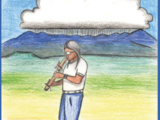
In traditional Ute culture, the flute was used for healing ceremonies, or sometimes for courting. A man would play a song to win the heart of a woman. According to tradition, only she could hear the music being played for her. The White Mesa Utes, located in White Mesa, Utah, are members of the Ute Mountain Ute tribe. The Ute Mountain Ute tribal headquarters are located about 90 miles east, in Towoac, Colorado. This Ute Mountain Ute booklet is part of the Native American Indian Literacy Project storybook series for the six main Utah Tribal Nations. The project was led by Shirlee A. Silversmith, American Indian education specialist for the Utah State Office of Education. There are five stories per Tribe, with a total of 30 booklets, plus an ABC book. The set of Indian Tribal stories may be utilized by elementary classroom teachers to (1) develop an understanding and appreciation of Native American culture and societal contributions (2) provide a genre of text for the application of reading strategies, and (3) facilitate the mastery of various Utah Core Content Curriculum objectives. The Native American Indian Literacy Project was made possible by funds from the Utah State Office of Education (USOE). It is a joint effort of the USOE and San Juan School District Media Center.
The original set has 30 booklets, measuring 5.5” x 8.5” each, and illustrated by tribal members. The booklets were formatted to be printed and assembled. This version of the book has been updated to accommodate using a projector or smart board with pages appearing in order.
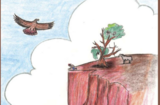
The Ute people have a close association with nature and a respect for all living things. They share the earth with animals, and they look to them for guidance. The Utes honor the hawk in ceremonies, and they use hawk feathers in their regalia. This Ute Mountain Ute booklet is part of the Native American Indian Literacy Project storybook series for the six main Utah Tribal Nations. The project was led by Shirlee A. Silversmith, American Indian education specialist for the Utah State Office of Education. There are five stories per Tribe, with a total of 30 booklets, plus an ABC book. The set of Indian Tribal stories may be utilized by elementary classroom teachers to (1) develop an understanding and appreciation of Native American culture and societal contributions (2) provide a genre of text for the application of reading strategies, and (3) facilitate the mastery of various Utah Core Content Curriculum objectives. The Native American Indian Literacy Project was made possible by funds from the Utah State Office of Education (USOE). It is a joint effort of the USOE and San Juan School District Media Center.
The original set has 30 booklets, measuring 5.5” x 8.5” each, and illustrated by tribal members. The booklets were formatted to be printed and assembled. This version of the book has been updated to accommodate using a projector or smart board with pages appearing in order.

In the past the Goshutes held bear dances every spring, but many of the elders who believed in the traditional dances are no longer living. The Goshutes don't practice bear dances any more, but they have other dances. Some of the other dances are strictly social, and some are to celebrate the coming of new seasons and plants. Some dances are held to ask for moisture to bless Mother Earth. This Goshute booklet is part of the Native American Indian Literacy Project storybook series for the six main Utah Tribal Nations. The project was led by Shirlee A. Silversmith, American Indian education specialist for the Utah State Office of Education. There are five stories per Tribe, with a total of 30 booklets, plus an ABC book. The set of Indian Tribal stories may be utilized by elementary classroom teachers to (1) develop an understanding and appreciation of Native American culture and societal contributions (2) provide a genre of text for the application of reading strategies, and (3) facilitate the mastery of various Utah Core Content Curriculum objectives. The Native American Indian Literacy Project was made possible by funds from the Utah State Office of Education (USOE). It is a joint effort of the USOE and San Juan School District Media Center.
The full set has 30 booklets, measuring 5.5” x 8.5” each, and illustrated by tribal members. The booklets were formatted to be printed and assembled. This means that they do not read well when using a projector or smart board because the pages will appear out of order. If a teacher did want to use the books in an electronic format, they would be best off screenshotting the pages and arranging them in a slide presentation.

Students create a personalized biography for their reading buddy, and each child is the author, illustrator, and editor.

To the Ute people, the bear, quee yahgudt, is a sacred animal. He gave the Ute people their Bear Dance, which is held in the springtime after the first thunder. This Ute (Uintah/Ouray) booklet is part of the Native American Indian Literacy Project storybook series for the six main Utah Tribal Nations. The project was led by Shirlee A. Silversmith, American Indian education specialist for the Utah State Office of Education. There are five stories per Tribe, with a total of 30 booklets, plus an ABC book. The set of Indian Tribal stories may be utilized by elementary classroom teachers to (1) develop an understanding and appreciation of Native American culture and societal contributions (2) provide a genre of text for the application of reading strategies, and (3) facilitate the mastery of various Utah Core Content Curriculum objectives. The Native American Indian Literacy Project was made possible by funds from the Utah State Office of Education (USOE). It is a joint effort of the USOE and San Juan School District Media Center.
The original set has 30 booklets, measuring 5.5” x 8.5” each, and illustrated by tribal members. The booklets were formatted to be printed and assembled. This version of the book has been updated to accommodate using a projector or smart board with pages appearing in order.
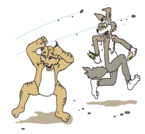
According to Navajo tradition, this is a winter tale. Coyote stories should only be told in the winter time. This Navajo story booklet is part of the Native American Indian Literacy Project storybook series for the six main Utah Tribal Nations. The project was led by Shirlee A. Silversmith, American Indian education specialist for the Utah State Office of Education. There are five stories per Tribe, with a total of 30 booklets, plus an ABC book. The set of Indian Tribal stories may be utilized by elementary classroom teachers to (1) develop an understanding and appreciation of Native American culture and societal contributions (2) provide a genre of text for the application of reading strategies, and (3) facilitate the mastery of various Utah Core Content Curriculum objectives. The Native American Indian Literacy Project was made possible by funds from the Utah State Office of Education (USOE). It is a joint effort of the USOE and San Juan School District Media Center.
The original set has 30 booklets, measuring 5.5” x 8.5” each, and illustrated by tribal members. The booklets were formatted to be printed and assembled. This version of the book has been updated to accommodate using a projector or smart board with pages appearing in order.
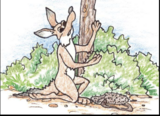
According to Goshute tradition, Coyote tales should only be told during the winter time. This Goshute story booklet is part of the Native American Indian Literacy Project storybook series for the six main Utah Tribal Nations. The project was led by Shirlee A. Silversmith, American Indian education specialist for the Utah State Office of Education. There are five stories per Tribe, with a total of 30 booklets, plus an ABC book. The set of Indian Tribal stories may be utilized by elementary classroom teachers to (1) develop an understanding and appreciation of Native American culture and societal contributions (2) provide a genre of text for the application of reading strategies, and (3) facilitate the mastery of various Utah Core Content Curriculum objectives. The Native American Indian Literacy Project was made possible by funds from the Utah State Office of Education (USOE). It is a joint effort of the USOE and San Juan School District Media Center.
The original set has 30 booklets, measuring 5.5” x 8.5” each, and illustrated by tribal members. The booklets were formatted to be printed and assembled. This version of the book has been updated to accommodate using a projector or smart board with pages appearing in order.

Stories with morals, like "Coyote and Bobcat," were often used by the Ute Mountain Ute people to teach their children about proper behavior and the consequences of their own actions. Coyote tales are only told during the winter time. This Ute Mountain Ute story booklet is part of the Native American Indian Literacy Project storybook series for the six main Utah Tribal Nations. The project was led by Shirlee A. Silversmith, American Indian education specialist for the Utah State Office of Education. There are five stories per Tribe, with a total of 30 booklets, plus an ABC book. The set of Indian Tribal stories may be utilized by elementary classroom teachers to (1) develop an understanding and appreciation of Native American culture and societal contributions (2) provide a genre of text for the application of reading strategies, and (3) facilitate the mastery of various Utah Core Content Curriculum objectives. The Native American Indian Literacy Project was made possible by funds from the Utah State Office of Education (USOE). It is a joint effort of the USOE and San Juan School District Media Center.
The original set has 30 booklets, measuring 5.5” x 8.5” each, and illustrated by tribal members. The booklets were formatted to be printed and assembled. This version of the book has been updated to accommodate using a projector or smart board with pages appearing in order.
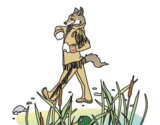
Coyote tales are part of the Paiute oral tradition used to teach proper behavior and values from an early age. If a story contains the Coyote character it is a winter time story that should only be told during the winter. The Coyote illustrates the mischievous nature in all of us. This Paiute Coyote Story booklet is part of the Native American Indian Literacy Project storybook series for the six main Utah Tribal Nations. The project was led by Shirlee A. Silversmith, American Indian education specialist for the Utah State Office of Education. There are five stories per Tribe, with a total of 30 booklets, plus an ABC book. The set of Indian Tribal stories may be utilized by elementary classroom teachers to (1) develop an understanding and appreciation of Native American culture and societal contributions (2) provide a genre of text for the application of reading strategies, and (3) facilitate the mastery of various Utah Core Content Curriculum objectives. The Native American Indian Literacy Project was made possible by funds from the Utah State Office of Education (USOE). It is a joint effort of the USOE and San Juan School District Media Center.
The original set has 30 booklets, measuring 5.5” x 8.5” each, and illustrated by tribal members. The booklets were formatted to be printed and assembled. This version of the book has been updated to accommodate using a projector or smart board with pages appearing in order.
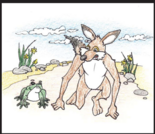
According to Goshute tradition, Coyote tales should only be told during the winter time. Traditional Goshute elders are botanists. They use many herbs and plants from the area for food, medicine, and spiritual healing. This Goshute story booklet is part of the Native American Indian Literacy Project storybook series for the six main Utah Tribal Nations. The project was led by Shirlee A. Silversmith, American Indian education specialist for the Utah State Office of Education. There are five stories per Tribe, with a total of 30 booklets, plus an ABC book. The set of Indian Tribal stories may be utilized by elementary classroom teachers to (1) develop an understanding and appreciation of Native American culture and societal contributions (2) provide a genre of text for the application of reading strategies, and (3) facilitate the mastery of various Utah Core Content Curriculum objectives. The Native American Indian Literacy Project was made possible by funds from the Utah State Office of Education (USOE). It is a joint effort of the USOE and San Juan School District Media Center.
The original set has 30 booklets, measuring 5.5” x 8.5” each, and illustrated by tribal members. The booklets were formatted to be printed and assembled. This version of the book has been updated to accommodate using a projector or smart board with pages appearing in order.

According to Shoshone tradition, Coyote tales should only be told during the winter. This Shoshone story booklet is part of the Native American Indian Literacy Project storybook series for the six main Utah Tribal Nations. The project was led by Shirlee A. Silversmith, American Indian education specialist for the Utah State Office of Education. There are five stories per Tribe, with a total of 30 booklets, plus an ABC book. The set of Indian Tribal stories may be utilized by elementary classroom teachers to (1) develop an understanding and appreciation of Native American culture and societal contributions (2) provide a genre of text for the application of reading strategies, and (3) facilitate the mastery of various Utah Core Content Curriculum objectives. The Native American Indian Literacy Project was made possible by funds from the Utah State Office of Education (USOE). It is a joint effort of the USOE and San Juan School District Media Center.
The original set has 30 booklets, measuring 5.5” x 8.5” each, and illustrated by tribal members. The booklets were formatted to be printed and assembled. This version of the book has been updated to accommodate using a projector or smart board with pages appearing in order.
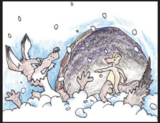
According to Goshute tradition, Coyote tales should only be told during the winter time. This Goshute story booklet is part of the Native American Indian Literacy Project storybook series for the six main Utah Tribal Nations. The project was led by Shirlee A. Silversmith, American Indian education specialist for the Utah State Office of Education. There are five stories per Tribe, with a total of 30 booklets, plus an ABC book. The set of Indian Tribal stories may be utilized by elementary classroom teachers to (1) develop an understanding and appreciation of Native American culture and societal contributions (2) provide a genre of text for the application of reading strategies, and (3) facilitate the mastery of various Utah Core Content Curriculum objectives. The Native American Indian Literacy Project was made possible by funds from the Utah State Office of Education (USOE). It is a joint effort of the USOE and San Juan School District Media Center.
The original set has 30 booklets, measuring 5.5” x 8.5” each, and illustrated by tribal members. The booklets were formatted to be printed and assembled. This version of the book has been updated to accommodate using a projector or smart board with pages appearing in order.

The buffalo was a giver of life to the Ute people. It is a sacred animal and part of the circle of life. Every part of the buffalo was used; nothing was wasted. For example, the hides were used for blankets and for covering the teepee and sweat lodge. The hooves were used for making utensils. When the Utes first encountered African Americans, they referred to them as "buffalo people,: because their curly hair resembled the curly hair on the mane of the buffalo. According to Ute tradition, Coyote stories should only be told during the winter time. This Ute (Uintah/Ouray) booklet is part of the Native American Indian Literacy Project storybook series for the six main Utah Tribal Nations. The project was led by Shirlee A. Silversmith, American Indian education specialist for the Utah State Office of Education. There are five stories per Tribe, with a total of 30 booklets, plus an ABC book. The set of Indian Tribal stories may be utilized by elementary classroom teachers to (1) develop an understanding and appreciation of Native American culture and societal contributions (2) provide a genre of text for the application of reading strategies, and (3) facilitate the mastery of various Utah Core Content Curriculum objectives. The Native American Indian Literacy Project was made possible by funds from the Utah State Office of Education (USOE). It is a joint effort of the USOE and San Juan School District Media Center.
The original set has 30 booklets, measuring 5.5” x 8.5” each, and illustrated by tribal members. The booklets were formatted to be printed and assembled. This version of the book has been updated to accommodate using a projector or smart board with pages appearing in order.
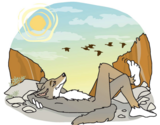
Coyote tales are part of the Paiute oral tradition used to teach proper behavior and values from an early age. These stories are only told during the winter time. The Coyote illustrates the mischievous nature in all of us. This Paiute story booklet is part of the Native American Indian Literacy Project storybook series for the six main Utah Tribal Nations. The project was led by Shirlee A. Silversmith, American Indian education specialist for the Utah State Office of Education. There are five stories per Tribe, with a total of 30 booklets, plus an ABC book. The set of Indian Tribal stories may be utilized by elementary classroom teachers to (1) develop an understanding and appreciation of Native American culture and societal contributions (2) provide a genre of text for the application of reading strategies, and (3) facilitate the mastery of various Utah Core Content Curriculum objectives. The Native American Indian Literacy Project was made possible by funds from the Utah State Office of Education (USOE). It is a joint effort of the USOE and San Juan School District Media Center.
The original set has 30 booklets, measuring 5.5” x 8.5” each, and illustrated by tribal members. The booklets were formatted to be printed and assembled. This version of the book has been updated to accommodate using a projector or smart board with pages appearing in order.
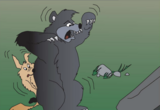
According to Shoshone tradition, Coyote tales should only be told during the winter time. The People of the Big Shield are a warrior society of the Shoshone tribe who are known for their big shields and fearless nature. Beads and ornamentation on Shoshone regalia are placed, not as decoration, but as powerful objects to fend off evil and the enemy. Feathers are earned for great courage and are worn on the upper arm of the warrior. Many warriors decorate the armband with beads on which eagle feathers dangle. This Shoshone story booklet is part of the Native American Indian Literacy Project storybook series for the six main Utah Tribal Nations. The project was led by Shirlee A. Silversmith, American Indian education specialist for the Utah State Office of Education. There are five stories per Tribe, with a total of 30 booklets, plus an ABC book. The set of Indian Tribal stories may be utilized by elementary classroom teachers to (1) develop an understanding and appreciation of Native American culture and societal contributions (2) provide a genre of text for the application of reading strategies, and (3) facilitate the mastery of various Utah Core Content Curriculum objectives. The Native American Indian Literacy Project was made possible by funds from the Utah State Office of Education (USOE). It is a joint effort of the USOE and San Juan School District Media Center.
The original set has 30 booklets, measuring 5.5” x 8.5” each, and illustrated by tribal members. The booklets were formatted to be printed and assembled. This version of the book has been updated to accommodate using a projector or smart board with pages appearing in order.
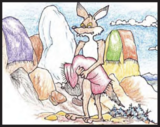
According to Goshute tradition, Coyote tales should only be told during the winter time. Rabbit fur blankets were made from wild rabbit skins that were sewn together and worn by the Goshute and Shoshone people. This Goshute story booklet is part of the Native American Indian Literacy Project storybook series for the six main Utah Tribal Nations. The project was led by Shirlee A. Silversmith, American Indian education specialist for the Utah State Office of Education. There are five stories per Tribe, with a total of 30 booklets, plus an ABC book. The set of Indian Tribal stories may be utilized by elementary classroom teachers to (1) develop an understanding and appreciation of Native American culture and societal contributions (2) provide a genre of text for the application of reading strategies, and (3) facilitate the mastery of various Utah Core Content Curriculum objectives. The Native American Indian Literacy Project was made possible by funds from the Utah State Office of Education (USOE). It is a joint effort of the USOE and San Juan School District Media Center. See "Language Arts/Dance with ”Coyote...Rolling Stone" https://www.uen.org/lessonplan/view/16980.
The original set has 30 booklets, measuring 5.5” x 8.5” each, and illustrated by tribal members. The booklets were formatted to be printed and assembled. This version of the book has been updated to accommodate using a projector or smart board with pages appearing in order.
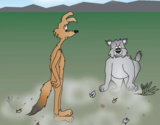
According to Shoshone tradition, Coyote tales should only be told during the winter time. Instead of using the "lecture" method of teaching morals and life lessons, Shoshone parents use tales such as "Handsome Coyote and Wildcat" to teach their children that there are consequences for their actions. This Shoshone story booklet is part of the Native American Indian Literacy Project storybook series for the six main Utah Tribal Nations. The project was led by Shirlee A. Silversmith, American Indian education specialist for the Utah State Office of Education. There are five stories per Tribe, with a total of 30 booklets, plus an ABC book. The set of Indian Tribal stories may be utilized by elementary classroom teachers to (1) develop an understanding and appreciation of Native American culture and societal contributions (2) provide a genre of text for the application of reading strategies, and (3) facilitate the mastery of various Utah Core Content Curriculum objectives. The Native American Indian Literacy Project was made possible by funds from the Utah State Office of Education (USOE). It is a joint effort of the USOE and San Juan School District Media Center.
The original set has 30 booklets, measuring 5.5” x 8.5” each, and illustrated by tribal members. The booklets were formatted to be printed and assembled. This version of the book has been updated to accommodate using a projector or smart board with pages appearing in order.